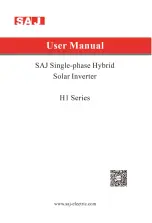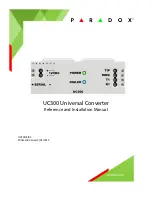
53
ECO-ECP iMANUAL December 2013 Rev. 03
DSR regulator, on board of new generators, is already calibrated; in case of loose regulators (ie spare parts) or in case of wiring modi-
fications or adjusting, to guarantee its correct working, it must be accurately set .
Basic settings can be done directly on the regulator by its four trimmers (VOLT - STAB - Hz - AMP), the jumper 50/60 and the Vext
input. More detailed settings or measures can be done exclusively by software using for example the MeccAlte communication interfa-
ce DI1 and the program DSR_Terminal or DSR_Reader.
Vext Input
The Vext input (connector CN1
– terminals 10 and 11) permits analogical remote control of output voltage through a 10Kohm poten-
tiometer with a programmable variation range through parameter 16 with respect to the value set (by default the setting is ±14% star-
ting from revision 10 of the Firmware); if you want to use continuous voltage, it will be effective if it is in the range between 0V and
+2,5V. The input tolerates voltages from -5V to +5V, but for values exceeding the limits of 0V / +2,5V (or in the event of disconnec-
tion), two options are possible: not to take the set point of external input (default configuration) and return to regulation to the voltage
value set with the trimmer (if enabled) or with parameter 19, or keep the minimum (or maximum) value of voltage that can be reached.
The two options can be set with the
RAM Voltage CTRL
flag in the
Configuration
menu corresponding to the bit B7 of the configura-
tion word P[10].
NOTE
: The DC voltage generator must be able to sink al least 2mA. In making adjustments it is reccomended not to exceed the no-
minal value of voltage of the alternator beyond ± 10%
50/60 Signal
A jumper is located on the 50/60 input (connector CN1, terminals 12 and 13); it provokes the commutation of the underspeed protec-
tion threshold from 50·(100%-
αHz%) to 60·(100%-αHz%), where αHz% represents the position relative to the Hz trimmer.
APO Contact
The acronym APO stands for
A
ctive
P
rotection
O
utput: (connector CN1
– terminals 14 and 15) 30V-100mA non-insulated open col-
lector transistor, normally opened, is closed (with a delay that can be programmed by software from 1 to 15 seconds) when, among all
the alarms, one or more of the active ones can be selected separately by software.
The
VOLT trimmer
allows adjustment from about 70V to about 140V when using for sensing terminals 4 and 5, or from about 140V to
about 280V when using terminals 6 and 7.
The
STAB trimmer
adjusts the dynamic response (statism) of the alternator under transient conditions.
The
AMP trimmer
adjusts the excitation overcurrent protection intervention threshold.
Use the following procedure in order to calibrate the overload protection:
1) Rotate the Hz trimmer entirely in the counter clockwise direction
2) Apply the nominal load to the alternator.
3) Decrease the speed by 10%
4) Rotate the AMP trimmer completely in the counter clockwise direction.
5) After a few seconds, there should be a decrease in the voltage value of the generator and alarm 5 should come on (visible due to
a change in the flashing indicator light) .
6) Under these conditions, rotate the AMP trimmer slowly in the clockwise direction, until the output voltage value is 97% of the no-
minal value: alarm 5 is still activated.
7) Return to the nominal speed; alarm 5 should disappear in a few seconds and the generator voltage should increase to the nomi-
nal value.
8) Re-adjust the trimmer as indicated in the following paragraph.
The
Hz trimmer
allows to calibrate the threshold of the intervention of the under frequency protection up to -20% with respect to the
nominal speed value set by jumper 50/60 (at 50 Hz the threshold can be calibrated from 40 Hz to 50 Hz, at 60 Hz the threshold can
be calibrated from 48 Hz to 60 Hz).
The intervention of this protection reduce the output generator voltage and, to calibrate it, use the following procedure :
1) Rotate the Hz trimmer entirely in the counter clockwise direction.
2) If the machine has to operate at 60 Hz, ensure that the bridge is inserted between terminals 12 and 13 of the CN1 connector.
3) Bring the generator to 90% of the nominal speed.
4) Slowly turn the “Hz” trimmer, rotating it clockwise until the generator voltage begins to drop and ascertain that the indicator light
simultaneously begins flashing rapidly.
5) By increasing speed, the generator voltage will normalise and the alarm will disappear.
6) Set the speed to the nominal value.
During normal operation and a duty cycle of 50% an indicator light mounted on the board flashes every 2 seconds; it flashes different-
ly in the event of intervention or alarm, as indicated in figure 1.
NOTE:
Notwithstanding DSR maintains the voltage regulation, it goes in shutdown mode if the frequency decreases under 20Hz.
The reset needs the Gen-Set switching off
.
Summary of Contents for ECO-ECP 2
Page 309: ...309 ECO ECP iMANUAL December 2013 Rev 03 ECO ECP IMPORTANT...
Page 310: ...310 ECO ECP iMANUAL December 2013 Rev 03 ECO ECP Mecc Alte...
Page 311: ...311 ECO ECP iMANUAL December 2013 Rev 03 ECO ECP 30 349 25 40 C 1000 EN60034 1...
Page 312: ...312 ECO ECP iMANUAL December 2013 Rev 03 ECO ECP 349 25 IP21...
Page 313: ...313 ECO ECP iMANUAL December 2013 Rev 03 ECO ECP MD35 349 25 1 EN60204 1 50 60...
Page 314: ...314 ECO ECP iMANUAL December 2013 Rev 03 ECO ECP 348 24 40 C...
Page 316: ...316 ECO ECP iMANUAL December 2013 Rev 03 ECO ECP g ECP28 h i 28 20 Nm 10 l h i...
Page 321: ...321 ECO ECP iMANUAL December 2013 Rev 03 ECO ECP 42 23 ECO ECP...
Page 324: ...324 ECO ECP iMANUAL December 2013 Rev 03 ECO ECP 28 31 32 34 38 40 43 46 38 40 43 46 A B...
Page 325: ...325 ECO ECP iMANUAL December 2013 Rev 03 ECO ECP 38 40 43 46...
Page 326: ...326 ECO ECP iMANUAL December 2013 Rev 03 ECO ECP b c I 60 80 C...
Page 330: ...330 ECO ECP iMANUAL December 2013 Rev 03 ECO ECP g 12V 30W Mecc Alte...
Page 331: ...331 ECO ECP iMANUAL December 2013 Rev 03 ECO ECP 15 12V 30 0 8 4 STAB Mecc Alte...
Page 333: ...333 ECO ECP iMANUAL December 2013 Rev 03 ECO ECP ECO 40 ECO 43N ECO 46...
Page 336: ...336 ECO ECP iMANUAL December 2013 Rev 03 ECO ECP 2 3...
Page 337: ...337 ECO ECP iMANUAL December 2013 Rev 03 ECO ECP S R 7 2 G 4 U V R 6 1 F 5 PD 350KVA PD...
Page 338: ...338 ECO ECP iMANUAL December 2013 Rev 03 ECO ECP 4A S R 7 2 G 12 U V R 6 1 F 12 5A...
Page 339: ...339 ECO ECP iMANUAL December 2013 Rev 03 ECO ECP 12 6 7 PD 350KVA PD...
Page 341: ...341 ECO ECP iMANUAL December 2013 Rev 03 ECO ECP 10 S R 7 2 G U V R 6 1 F 11 PD 350KVA PD...
Page 342: ...342 ECO ECP iMANUAL December 2013 Rev 03 ECO ECP 28 32 12 28 32 34 13...
Page 343: ...343 ECO ECP iMANUAL December 2013 Rev 03 ECO ECP 14 28 32 15 34...
Page 344: ...344 ECO ECP iMANUAL December 2013 Rev 03 ECO ECP 16 17 34 38 40 ECO40 ECO38N...
Page 345: ...345 ECO ECP iMANUAL December 2013 Rev 03 ECO ECP 18 19 38 38...
Page 346: ...346 ECO ECP iMANUAL December 2013 Rev 03 ECO ECP 20 21 40 43...
Page 370: ...370 ECO ECP iMANUAL December 2013 Rev 03 ECO ECP IMPORTANTE...
Page 371: ...371 ECO ECP iMANUAL December 2013 Rev 03 ECO ECP Mecc Alte...
Page 372: ...372 ECO ECP iMANUAL December 2013 Rev 03 ECO ECP 30 25 44 40 C 1000 EN60034 1...
Page 373: ...373 ECO ECP iMANUAL December 2013 Rev 03 ECO ECP 25 44 IP21...
Page 374: ...374 ECO ECP iMANUAL December 2013 Rev 03 ECO ECP MD35 25 44 1 EN60204 1 50 60 C...
Page 375: ...375 ECO ECP iMANUAL December 2013 Rev 03 ECO ECP 24 43 40 C B3 B14...
Page 376: ...376 ECO ECP iMANUAL December 2013 Rev 03 ECO ECP MD35 a L 24 43 L 0 5 2 28 28 8 28 d MD35...
Page 377: ...377 ECO ECP iMANUAL December 2013 Rev 03 ECO ECP ECP28 28 20 10 i l...
Page 382: ...382 ECO ECP iMANUAL December 2013 Rev 03 ECO ECP ECO ECP Mecc Alte 23 42...
Page 383: ...383 ECO ECP iMANUAL December 2013 Rev 03 ECO ECP 500 1 50 60 C fig a fig b fig c...
Page 386: ...386 ECO ECP iMANUAL December 2013 Rev 03 ECO ECP 38 40 43 46...
Page 387: ...387 ECO ECP iMANUAL December 2013 Rev 03 ECO ECP Solvesso 60 80 C...
Page 391: ...391 ECO ECP iMANUAL December 2013 Rev 03 ECO ECP 12 30 Mecc Alte...
Page 394: ...394 ECO ECP iMANUAL December 2013 Rev 03 ECO ECP ECO 40 ECO 43N ECO 46...
Page 397: ...397 ECO ECP iMANUAL December 2013 Rev 03 ECO ECP 2 3...
Page 398: ...398 ECO ECP iMANUAL December 2013 Rev 03 ECO ECP S R 7 2 G 4 U V R 6 1 F 5 PD 350 P...
Page 399: ...399 ECO ECP iMANUAL December 2013 Rev 03 ECO ECP 4A 12 S R 7 2 G 12 U V R 6 1 F 5A...
Page 400: ...400 ECO ECP iMANUAL December 2013 Rev 03 ECO ECP 12 6 7 PD 350 P...
Page 401: ...401 ECO ECP iMANUAL December 2013 Rev 03 ECO ECP 12 S R 7 2 G 8 9 12 U V R 6 1 F...
Page 402: ...402 ECO ECP iMANUAL December 2013 Rev 03 ECO ECP 10 S R 7 2 G 11 U V R 6 1 F PD 350 P...
Page 403: ...403 ECO ECP iMANUAL December 2013 Rev 03 ECO ECP 28 32 12 28 32 34 13...
Page 404: ...404 ECO ECP iMANUAL December 2013 Rev 03 ECO ECP 14 28 32 15 34...
Page 405: ...405 ECO ECP iMANUAL December 2013 Rev 03 ECO ECP 16 17 34 38 40 ECO40 ECO38N...
Page 406: ...406 ECO ECP iMANUAL December 2013 Rev 03 ECO ECP 18 19 38 38...
Page 407: ...407 ECO ECP iMANUAL December 2013 Rev 03 ECO ECP 20 21 40 43...
Page 427: ...427 ECO ECP iMANUAL December 2013 Rev 03 ECO ECP SCC0203 00 300 600 SCC0202 00 300 600...
















































